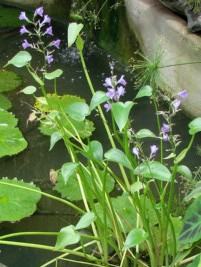The genus Eichhornia, commonly known as Water Hyacinth, encompasses several species of aquatic plants. Among them, the Brazilian Water Hyacinth (Eichhornia paniculata) stands out for its unique characteristics. This perennial plant is native to the northern and northeastern regions of Brazil, predominantly found along the banks of rivers and lakes, where it plays an important ecological role.
Unlike its more well-known relative, Eichhornia crassipes, known for its dense and large inflorescences, E. paniculata features more delicate and elongated inflorescences, of the panicle type, with over a hundred purple, hermaphroditic flowers. These smaller, elegant flowers are a visual attraction in the aquatic environment and also play a crucial role in biodiversity, attracting a variety of pollinators such as bees and butterflies.
E. paniculata is a herbaceous, flowering, and aquatic plant, adapted to aquatic environments. Its stoloniferous stem allows the plant to spread easily, anchoring its roots in the mud. During flooding, these roots can detach, making the plant temporarily float until it finds a new location for anchorage. This characteristic, while beneficial for its survival in dynamic environments, also contributes to its invasive potential.
The leaves of E. paniculata are another notable aspect. Heart-shaped, green, glossy, and sessile, they emerge in a basal rosette arrangement or on petioles that rise above the water. The arrangement of its foliage creates an ideal shelter for many aquatic beings, such as small frogs, fry, insects, etc., providing shade, nutrition, and hiding places. Flowering mainly occurs in spring and summer, when the climatic conditions are more favorable.
For cultivation, E. paniculata requires specific conditions. It should be planted in full sun, on the banks of ponds, lakes, or water bodies, and can be placed directly in the soil or in pots prepared with abundant organic matter. The species also adapts well to low-lying, waterlogged areas, such as floodplains. However, it is sensitive to cold and to very strong water currents, which can uproot the plants.
Its use in landscaping is valued for its beauty and ability to purify water, absorbing excess nutrients and contributing to the health of the aquatic ecosystem. However, it is important to be aware of its invasive potential. For example, in the state of Florida, United States, its cultivation is prohibited. Careful management and control of the spread of E. paniculata are essential to avoid negative impacts on local ecosystems. It is necessary to cultivate it in environments that can be isolated and monitored, avoiding planting on riverbanks or in lakes that communicate during the rainy season.
The reproduction of E. paniculata occurs both by seeds and by division of the clumps. Its natural growth and multiplication in favorable environments are quite rapid. Thus, it can be employed to depollute eutrophicated or polluted areas. However, periodic removals of green mass are necessary to prevent the plant from completely covering the water.


